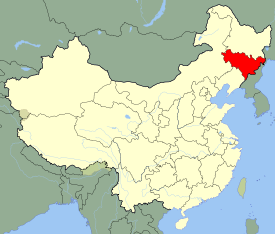Jilin City
| Jilin City 吉林市 |
|
|---|---|
| — Prefecture-level city — | |
| Chinese transcription(s) | |
| - Chinese | 吉林 |
| - Pinyin | Jílín |
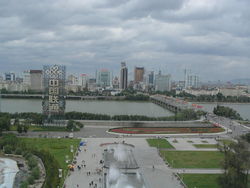 |
|
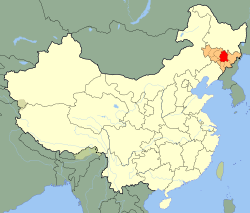 |
|
| Coordinates: | |
| Country | China |
| Province | Jilin |
| Area | |
| - Total | 27,700 km2 (10,695 sq mi) |
| Population | |
| - Total | 4,500,000 |
| - Density | 162.5/km2 (420.8/sq mi) |
| Time zone | China Standard (UTC+8) |
| Area code(s) | 432 |
| GDP per capita | ¥30,065 (2008) |
| Major Nationalities | Han, Manchu, Korean, Hui |
| County-level divisions | 9 |
| Township-level divisions | unknown |
| Website | http://www.jlcity.gov.cn/ |
Jilin City (Chinese: 吉林市; pinyin: Jílín Shì) is the second largest prefecture-level city in Jilin Province in China. It has a population of 1,985,000 (metropolitan 4,514,000)[1] and a metropolitan area of 27,120 km². Jilin is the only major city with a homologous name to the province which it is located. In 2007, Jilin City hosted the 2007 Asian Winter Games.
Jilin City is also called River City (Chinese: 江城), which was originated from one sentence, "Chinese: 连樯接舰屯江城", of a poem written by Kangxi Emperor when he was visiting Jilin City in 1682. The alias name is also because of the Songhua River surrounding almost the whole city.
Contents |
Geography
Jilin City is situated in a hilly area near the Songhua River. There are four famous mountains surrounding Jilin City, which is North Mountain in the west, Long Tan Mountain in the east, Zhuque Mountain in the North, and Turtle Mountain in the south, plus Songhua River, it forms a buagua in Taiji pattern. North Mountain, called Beishan, is the most famous mountain in Jilin City. It's said, Emperor Qianlong had come and visited the mountain. It is also said that there are several Buddhist temples on the mountain.
Administrative divisions
| Map | ||||||
|---|---|---|---|---|---|---|
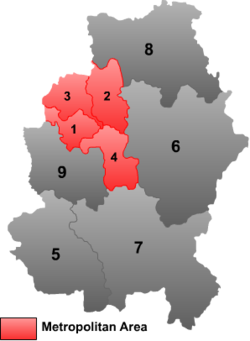 |
||||||
| # | Name | Hanzi | Hanyu Pinyin | Population (2003 est.) | Area (km²) | Density (/km²) |
| 1 | Chuanying District | 船营区 | Chuányíng Qū | 450,000 | 711 | 633 |
| 2 | Longtan District | 龙潭区 | Lóngtán Qū | 500,000 | 1,209 | 414 |
| 3 | Changyi District | 昌邑区 | Chāngyì Qū | 590,000 | 865 | 682 |
| 4 | Fengman District | 丰满区 | Fēngmǎn Qū | 250,000 | 1,032 | 242 |
| 5 | Panshi City | 磐石市 | Pánshí Shì | 540,000 | 3,867 | 140 |
| 6 | Jiaohe City | 蛟河市 | Jiāohé Shì | 460,000 | 6,235 | 74 |
| 7 | Huadian City | 桦甸市 | Huàdiàn Shì | 450,000 | 6,624 | 68 |
| 8 | Shulan City | 舒兰市 | Shūlán Shì | 660,000 | 4,554 | 145 |
| 9 | Yongji County | 永吉县 | Yǒngjí Xiàn | 390,000 | 2,625 | 149 |
Tourism
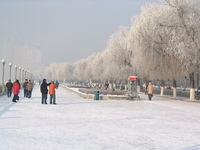
Jilin City is a popular destination for tourists to come each winter to view the magnificent rime ice (simplified Chinese: 雾凇; traditional Chinese: 霧凇) on trees along the banks of the Songhua River, (the river is the only river in the region that doesn't freeze in winter). The rime ice is a natural phenomenon that occurs every year during January and February. It is a result of when water vapor rises up from the warm Songhua River to meet the cold -20 °C night air, causing the crystallisation of water vapour on willows branches. The ice-rimed trees in Jilin are one of the four natural wonders of China, along with the Guilin Mountains and Streams, Yunnan Stone Forest, and Three Gorges on the Yangtze River.
Attractions:
- Meteorite Museum (largest stony meteorite of a documented meteorite fall)
- North Hill Park (North-West of Jilin)
- Dragon Pool Mountain Park
- Songhua Lake (South-East of Jilin)
Sports
The winter sports in Jilin City are full of interests, such as skiing, skating, sledding, snowboarding, and winter swim.
Ski resorts:
- North Big Lake ski resort
- Songhua Lake ski resort
- North Hill ski resort
- Zhuque Hill ski resort
Winter swimming is widely practised in Jilin city.
International relations
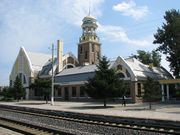
Twin towns — Sister cities
Jilin City is twinned with:
 Nakhodka Primorsky krai Russia (1991)
Nakhodka Primorsky krai Russia (1991) Spokane, Washington United States of America
Spokane, Washington United States of America Cherkasy Ukraine
Cherkasy Ukraine Östersund Sweden
Östersund Sweden Volgograd Russia
Volgograd Russia
See also
- Jilin chemical plant explosions 2005
References
- ↑ Jilin City Government Population Page.. As of 2003.
External links
- Official Jilin City government website (Chinese)
|
|||||||||||||||
